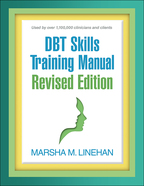DBT Teams
Development and Practice
Jennifer H. R. Sayrs and Marsha M. Linehan
HardcoverPaperbacke-bookprint + e-book
Hardcover
orderJuly 17, 2019
ISBN 9781462539826
Price: $53.00 226 Pages
Size: 6" x 9"
Paperback
orderJuly 26, 2019
ISBN 9781462539819
Price: $35.00226 Pages
Size: 6" x 9"
Check out Guilford Digital for DBT, the app that streamlines key aspects of DBT delivery and skills training, from customizable diary cards to Marsha Linehan's complete skills library.
Sign up for emails on upcoming titles on Dialectical Behavior Therapy (DBT) (with special discounts)!
The reproducible materials can be downloaded and printed in PDF format.
“In my experience, the team is the least focused-on and yet most critical component of the delivery of DBT. Working with clients with extremely challenging conditions can lead to burnout, helplessness, despair, and resignation. It is the role of the team to prevent that from happening—and teams need to adhere to the protocols and principles of DBT in order to function effectively. Sayrs and Linehan's book is clear, compassionate, methodical, and comprehensive. It provides essential practices for all consultation teams, whether newly formed or well established.”

—Blaise Aguirre, MD, Founding Medical Director, 3East DBT Continuum, McLean Hospital; Department of Psychiatry, Harvard Medical School
“A fabulous book. The principles and strategies for implementing a DBT team described in this volume are useful for all psychotherapists. Teams help prevent and address burnout, reduce drift, and promote learning, so that therapists can take their skills to the highest level. The list of team agreements alone is worth the price of the book! It includes items like: 'Be willing to call out the "elephant in the room" when others do not.'”

—Jacqueline B. Persons, PhD, Director, Oakland Cognitive Behavior Therapy Center
“It takes a village to really do DBT, yet creating that village is far from easy. Nothing in graduate or medical school prepared most of us to get emotionally vulnerable with peers, help colleagues find their way when they’re therapeutically lost, or speak directly about concerns that a particular patient is getting worse and not better. This book distills decades of experimentation and thinking about how to develop and sustain strong, vibrant DBT teams. Highly accessible, it breaks down the 'whats' and 'how-tos' of consultation teams into easy-to-follow steps and strategies. Each chapter concludes with practical exercises. Innovations include expanded team agreements and a thoughtful set of dialectical dilemmas for team leaders, as well as numerous clever team practices developed at the authors’ respective clinical settings.”

—Linda A. Dimeff, PhD, Director, Portland DBT Institute; Chief Scientific Officer and President, Evidence-Based Practice Institute, Seattle, Washington
“A 'must have' for every DBT therapist and every DBT program. Sayrs and Linehan spell out in specific detail how to add the key treatment element that sets DBT apart from other therapies for extremely vulnerable populations. Finally, the guidebook we have been waiting for on how to set up effective teams and clarify the roles of the participants, how to run teams in ways that truly make a difference, and what to do when problems arise. It's all here, including reproducible forms, examples of what to say (and what not to say), and practice exercises. Your team will run better and you will be a better team member if you read and apply what is in this book.”

—Joan C. Russo, PhD, President, DBT–Linehan Board of Certification
“This book shows how to accomplish the central task of the DBT consultation team—providing 'therapy for the therapist.' It is a comprehensive manual that is both deeply insightful and genuinely practical. Sayrs and Linehan describe the tools with which a group of DBT therapists create, structure, and conduct a consultation team; define meeting agendas and stick to them; balance dedication and rigor with vulnerability and flexibility; solve sticky and stubborn intrateam problems; and help each other with the ever-looming predicaments of suicide. The examples of problematic team functioning, with solutions brought from the authors’ own teams, are invaluable. This book is a brilliant synthesis, written in a straightforward manner by the best minds in DBT and studded with pearls of wisdom. It should be required reading for DBT newcomers and advanced clinicians alike.”

—Charles R. Swenson, MD, Department of Psychiatry, University of Massachusetts Medical School
“Practical and radically genuine, like a private DBT seminar tailored to the difficult and exhilarating work of DBT teams. I appreciate the clear guidelines and refreshingly straightforward advice and examples. Offering principles, not rules, this book is endlessly adaptable to the many settings where DBT is delivered and taught, and especially when exposure to traumatic content increases the risks of vicarious trauma and burnout. I will be pulling this book off the shelf often and will encourage all my colleagues and the students rotating through our program to read and use it.”

—Kathryn Kieran, MSN, Director of Nursing Operations, Hill Center for Women, McLean Hospital, Belmont, Massachusetts
—Blaise Aguirre, MD, Founding Medical Director, 3East DBT Continuum, McLean Hospital; Department of Psychiatry, Harvard Medical School
“A fabulous book. The principles and strategies for implementing a DBT team described in this volume are useful for all psychotherapists. Teams help prevent and address burnout, reduce drift, and promote learning, so that therapists can take their skills to the highest level. The list of team agreements alone is worth the price of the book! It includes items like: 'Be willing to call out the "elephant in the room" when others do not.'”
—Jacqueline B. Persons, PhD, Director, Oakland Cognitive Behavior Therapy Center
“It takes a village to really do DBT, yet creating that village is far from easy. Nothing in graduate or medical school prepared most of us to get emotionally vulnerable with peers, help colleagues find their way when they’re therapeutically lost, or speak directly about concerns that a particular patient is getting worse and not better. This book distills decades of experimentation and thinking about how to develop and sustain strong, vibrant DBT teams. Highly accessible, it breaks down the 'whats' and 'how-tos' of consultation teams into easy-to-follow steps and strategies. Each chapter concludes with practical exercises. Innovations include expanded team agreements and a thoughtful set of dialectical dilemmas for team leaders, as well as numerous clever team practices developed at the authors’ respective clinical settings.”
—Linda A. Dimeff, PhD, Director, Portland DBT Institute; Chief Scientific Officer and President, Evidence-Based Practice Institute, Seattle, Washington
“A 'must have' for every DBT therapist and every DBT program. Sayrs and Linehan spell out in specific detail how to add the key treatment element that sets DBT apart from other therapies for extremely vulnerable populations. Finally, the guidebook we have been waiting for on how to set up effective teams and clarify the roles of the participants, how to run teams in ways that truly make a difference, and what to do when problems arise. It's all here, including reproducible forms, examples of what to say (and what not to say), and practice exercises. Your team will run better and you will be a better team member if you read and apply what is in this book.”
—Joan C. Russo, PhD, President, DBT–Linehan Board of Certification
“This book shows how to accomplish the central task of the DBT consultation team—providing 'therapy for the therapist.' It is a comprehensive manual that is both deeply insightful and genuinely practical. Sayrs and Linehan describe the tools with which a group of DBT therapists create, structure, and conduct a consultation team; define meeting agendas and stick to them; balance dedication and rigor with vulnerability and flexibility; solve sticky and stubborn intrateam problems; and help each other with the ever-looming predicaments of suicide. The examples of problematic team functioning, with solutions brought from the authors’ own teams, are invaluable. This book is a brilliant synthesis, written in a straightforward manner by the best minds in DBT and studded with pearls of wisdom. It should be required reading for DBT newcomers and advanced clinicians alike.”
—Charles R. Swenson, MD, Department of Psychiatry, University of Massachusetts Medical School
“Practical and radically genuine, like a private DBT seminar tailored to the difficult and exhilarating work of DBT teams. I appreciate the clear guidelines and refreshingly straightforward advice and examples. Offering principles, not rules, this book is endlessly adaptable to the many settings where DBT is delivered and taught, and especially when exposure to traumatic content increases the risks of vicarious trauma and burnout. I will be pulling this book off the shelf often and will encourage all my colleagues and the students rotating through our program to read and use it.”
—Kathryn Kieran, MSN, Director of Nursing Operations, Hill Center for Women, McLean Hospital, Belmont, Massachusetts













